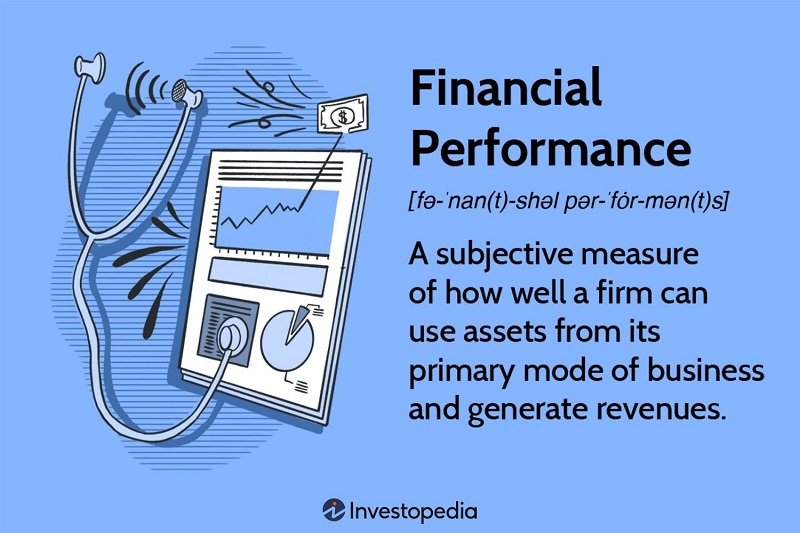
The $100,000 Mistake: Understanding Accounts Payable vs. Receivable
May 29, 2024
Confused About Available vs. Ledger Balance? This Will Save You Money!
June 11, 2024Part 1: Understanding Small Business Financial Performance
Having a strong grasp of your small business financial performance is crucial for navigating the ever-changing business landscape. It empowers you to make informed decisions, identify areas for improvement, and ultimately achieve your business goals.
Why Does Small Business Financial Performance Matter?
Understanding your financial performance is vital for several reasons:
- Informed Decision Making: Financial data provides valuable insights into your business’s health. It allows you to assess the effectiveness of your strategies, allocate resources efficiently, and make data-driven decisions for future growth.
- Securing Funding and Attracting Investors: When seeking funding from banks or investors, a robust financial performance is essential. Strong financial statements demonstrate your business’s stability and profitability, making you a more attractive candidate for loans and investments.
Key Challenges to Small Business Financial Performance
Despite the importance of financial health, small businesses often face challenges that can hinder their performance:
- Operational Challenges: Managing day-to-day operations, such as staffing shortages or disruptions in the supply chain, can negatively impact your bottom line.
- Financing Difficulties: Securing funding and managing debt can be a hurdle for small businesses, especially with rising interest rates.
- Post-pandemic Recovery: Many small businesses are still recovering from the economic effects of the pandemic.
Understanding these challenges allows you to proactively develop strategies to mitigate their impact.
Financial Statements for Small Businesses
Financial statements are the foundation for analyzing your small business financial performance. These documents provide a comprehensive picture of your business’s financial health at a specific point in time. The three key financial statements for small businesses are:
- Income Statement (Profit & Loss): This statement summarizes your revenue, expenses, and net income over a specific period.
- Balance Sheet: This statement provides a snapshot of your assets, liabilities, and shareholder equity at a specific date.
- Cash Flow Statement: This statement details the cash inflows and outflows of your business, highlighting your ability to generate cash.
By analyzing these statements, you can gain valuable insights into your profitability, solvency, and cash flow management.
Top 10 Key Performance Indicators (KPIs) for Small Businesses
Key Performance Indicators (KPIs) are quantifiable metrics that track your progress towards your business goals. They help you measure the effectiveness of your strategies and identify areas for improvement. The next section will delve deeper into the top 10 KPIs that can significantly impact your small business financial performance.
Part 2: Analyzing and Improving Small Business Financial Performance
Moving beyond understanding your financial statements, in-depth analysis is crucial for optimizing your small business financial performance. Here, we’ll explore key metrics and strategies to maximize profitability, manage cash flow effectively, and achieve sustainable growth.
Profitability Analysis
Profitability is a cornerstone of any successful business. Here, we’ll delve into key profitability metrics that measure your ability to generate profit from your revenue:
- Gross Profit Margin: This metric indicates the percentage of revenue remaining after accounting for the cost of goods sold. A higher gross profit margin signifies better efficiency in managing your direct costs.
- Operating Profit Margin: This metric takes a step further, factoring in operating expenses like rent, salaries, and utilities. It reflects your profitability after covering all operational costs.
- Net Profit Margin: This metric, also known as the bottom line, represents your net income as a percentage of total revenue. It reflects your overall profitability after accounting for all expenses, including taxes.
Analyzing these metrics can reveal areas for cost reduction or revenue growth to improve your overall profitability.

Cash Flow Analysis
Effective cash flow management is vital for the day-to-day operations of your business. Here are key cash flow metrics to monitor:
- Operating Cash Flow: This metric reflects the cash generated from your core business activities after accounting for operating expenses.
- Free Cash Flow: This metric represents the cash available for discretionary purposes after covering operating expenses and capital expenditures.
- Cash Flow Runway: This metric estimates the amount of time your business can operate with its current cash flow before requiring additional funding.
By monitoring these metrics, you can ensure you have sufficient cash on hand to meet your financial obligations and invest in future growth.
Customer Acquisition and Retention Analysis
Your customer base is the lifeblood of your business. Here are key metrics to analyze customer acquisition and retention:
- Customer Acquisition Cost (CAC): This metric represents the average cost of acquiring a new customer. Analyzing CAC helps you determine the efficiency of your marketing and sales efforts.
- Customer Lifetime Value (CLTV): This metric estimates the total revenue a customer is expected to generate throughout their relationship with your business. Focusing on CLTV allows you to prioritize strategies that retain existing customers.
By understanding your customer acquisition and retention costs, you can optimize your marketing and sales strategies to attract profitable customers and maximize their lifetime value.
Inventory Management Analysis
Efficient inventory management is crucial for maintaining healthy cash flow and preventing stockouts. Here are key metrics to track:
- Inventory Turnover Ratio: This metric measures how often your inventory is sold and replaced within a specific period. A higher ratio indicates efficient inventory management, while a lower ratio might suggest overstocking.
- Days Sales in Inventory (DSI): This metric indicates the average number of days it takes to sell your inventory. A lower DSI signifies faster inventory turnover, potentially freeing up cash flow.
By analyzing these metrics, you can optimize your inventory levels to minimize carrying costs and ensure you have the right amount of stock to meet customer demand.
Financial Performance Benchmarks for Small Businesses
Financial benchmarks provide a valuable reference point for evaluating your small business financial performance. By comparing your metrics to industry averages, you can assess your relative strengths and weaknesses. Here’s how benchmarking can benefit your business:
- Identify Areas for Improvement: By comparing your KPIs to industry benchmarks, you can identify areas where your performance falls short and develop targeted strategies for improvement.
- Set Realistic Goals: Benchmarks can help you set realistic and achievable financial goals for your business.
Several resources can help you find industry-specific financial benchmarks, including industry associations and online databases.
![]()
Strategies for Improving Small Business Financial Performance
Now that you have a framework for analyzing your financial performance, let’s explore strategies to enhance your profitability, cash flow, and overall financial health:
-
Cost Reduction Strategies:
- Renegotiate with suppliers for better pricing.
- Conduct a cost-benefit analysis of expenses to identify areas for streamlining.
- Implement energy-saving measures to reduce utility costs.
-
Revenue Growth Strategies:
- Develop new product lines or services.
- Expand your marketing efforts to reach new customer segments.
- Offer competitive pricing and promotional discounts.
-
Cash Flow Management Strategies:
- Collect outstanding receivables promptly.
- Negotiate longer payment terms with suppliers.
- Maintain a healthy inventory level to avoid stockouts and overstocking.
-
Financial Planning and Forecasting:
- Develop a comprehensive financial plan that outlines your business goals and strategies for achieving them.
- Create financial forecasts to predict future revenue, expenses, and cash flow.
- Regularly review and update your financial plan and forecasts to stay on track.
Implementing these strategies can significantly improve your small business financial performance and pave the way for sustainable growth.
Financial Tools and Resources for Small Businesses
Several financial tools and resources can assist you in managing your business finances more effectively:
- Accounting Software: Accounting software automates many financial tasks, saving you time and ensuring accuracy.
- Financial Forecasting Tools: These tools help you create financial projections and forecasts to guide your decision-making.
- Business Loan Options: Various loan options are available to support your business needs, such as equipment loans and lines of credit.
By leveraging these tools and resources, you can gain a deeper understanding of your financial situation and make informed choices for the future of your business.
FAQs: Small Business Financial Performance
This section addresses frequently asked questions (FAQs) regarding small business financial performance:
1. Q: How often should small businesses review their financial performance?
A: The frequency of reviewing your financial performance depends on your business and industry. However, it’s generally recommended to review key metrics monthly at a minimum. Additionally, a more in-depth analysis with financial statements is recommended quarterly or biannually.
2. Q: What are some signs of a struggling small business financially?
A: Here are some warning signs:
- Declining revenues and profits: This is a major red flag and indicates difficulty generating income.
- Cash flow problems: Struggling to meet financial obligations due to insufficient cash flow.
- Increasing debt: Rising debt levels can become a burden and limit your financial flexibility.
- Inventory issues: Overstocking or understocking can negatively impact cash flow and customer service.
- Difficulty paying suppliers: Falling behind on payments to suppliers can damage your reputation and creditworthiness.
If you notice any of these signs, it’s crucial to analyze your financial statements and implement corrective actions.
3. Q: How can small businesses improve their profit margins?
A: Several strategies can enhance your profit margins:
- Reduce costs: Identify and eliminate unnecessary expenses through cost-saving measures.
- Negotiate with suppliers: Renegotiate contracts with vendors to secure better pricing.
- Increase prices: Strategically raise prices while maintaining competitiveness.
- Improve operational efficiency: Streamline processes to minimize waste and maximize productivity.
- Focus on high-margin products or services: Prioritize offerings that generate the highest profit per sale.
By implementing these strategies, you can increase your profit margins and boost your bottom line.
4. Q: What are some free financial tools and resources for small businesses?
A: Several free resources can be valuable for small businesses:
- The U.S. Small Business Administration (SBA): The SBA website offers a wealth of information on financial management, including guides and templates. (https://www.sba.gov/)
- SCORE: SCORE provides free mentoring and educational resources to small business owners, including financial management workshops. (https://www.score.org/spacecoast/event/where-can-i-find-financing-my-small-business-11)
- Online financial calculators: Many websites offer free financial calculators to help you estimate loan payments, break-even points, and other metrics.
These resources can equip you with the knowledge and tools to manage your business finances effectively.
5. Q: How can small businesses secure funding for growth?
A: Several options exist for small businesses seeking funding:
- Small business loans: Banks and credit unions offer various loan options to finance business needs, such as equipment purchases and expansion plans.
- Lines of credit: A line of credit provides flexible access to funds for ongoing expenses.
- Small Business Administration (SBA) loans: The SBA offers loan programs with favorable terms for qualified small businesses.
- Angel investors and venture capitalists: For high-growth businesses, attracting angel investors or venture capitalists might be an option.
Carefully research each option and consider factors like interest rates, repayment terms, and eligibility criteria before applying for funding.
Resources
- SBA Guide to Financial Management for Small Businesses
- The Balance: Small Business Financial Resources
- SCORE Financial Resources for Small Business Owners
DISCLAIMER: The information in this article is for informational purposes only and is not meant to take the place of legal and accounting advice.




